This creamy, protein-rich curry features mushrooms and spinach in a silky coconut-milk sauce. With chicken, tofu, or shrimp, it's a filling main dish that doesn't need any sides.
Plus, it's dairy-free and gluten-free if you use chickpea pasta instead of regular semolina. This allergy-friendly dinner is also vegan if you choose tofu.
Clearly, you can customize this dish to suit your dietary needs, but if you've never tried chickpea pasta, give it a whirl. It plays well with the coconut sauce, has amazing nutrition benefits, and is a nice change of pace (er, pasta).
I earn from qualifying purchases at no extra cost to you as part of the Amazon Affiliate program.
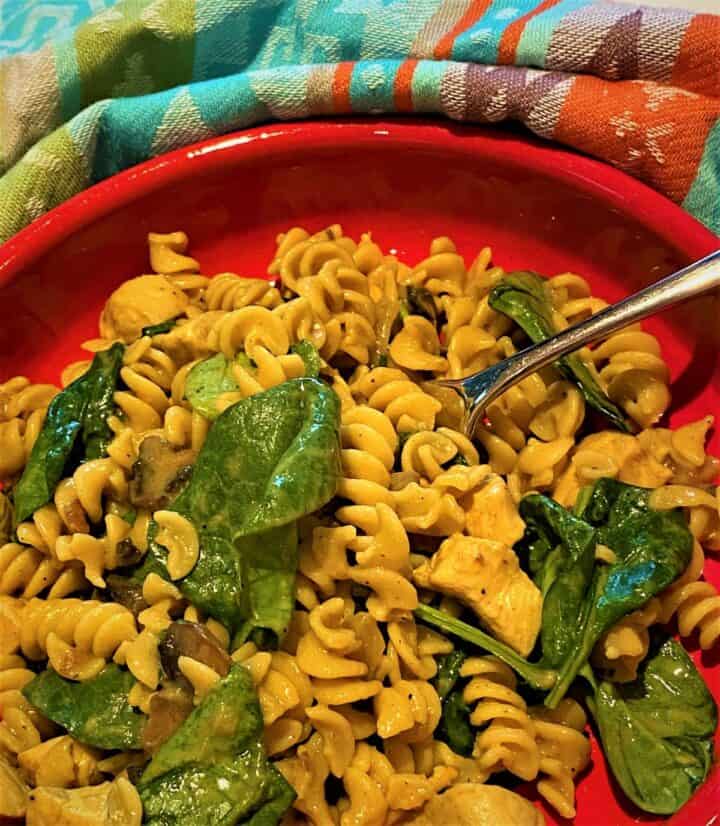
Would you like to save this recipe or article?
You won't get spam from me, I promise!
I developed this healthy combination for my daughter who has food allergies. She loves pasta and Asian flavors, but sometimes needs to avoid wheat, soy and eggs.
Ingredients
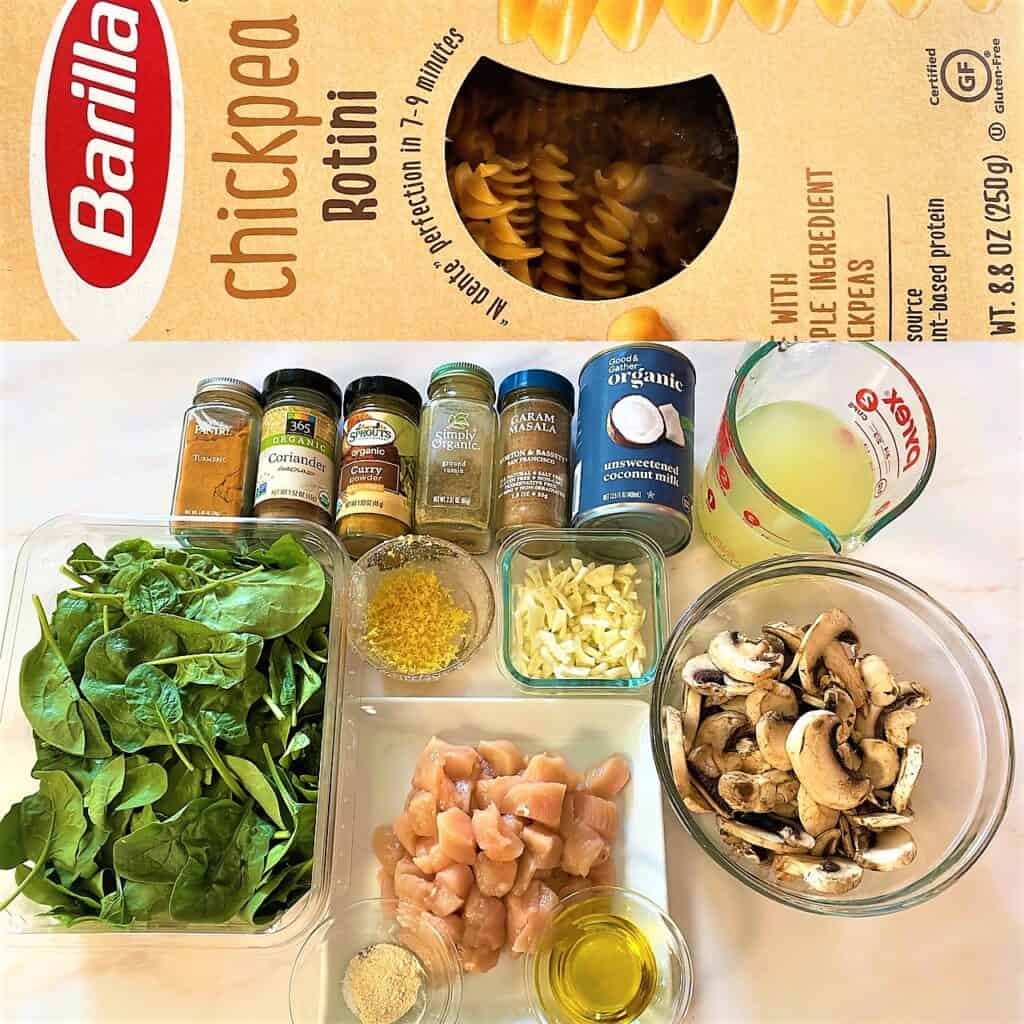
- Rotini or penne chickpea pasta or regular pasta
- Olive oil
- Chicken breast, tofu, or shrimp
- Fennel or onion
- Mushrooms
- Ginger root
- Curry powder
- Garlic powder
- Turmeric
- Cumin
- Coriander
- Garam masala
- Cayenne
- Kosher salt and coarse black pepper
- Chicken or vegetable broth
- Coconut milk
- Spinach
Olive oil: Use a medium, rounder-flavored oil. Canola, peanut, and any vegetable oil work well as substitutes.
Protein: The nutrition facts for this curry recipe were calculated with chicken breast, but tofu is a go-to if you want a vegan curry. Peeled, deveined shrimp are also delicious with the coconut-milk sauce.
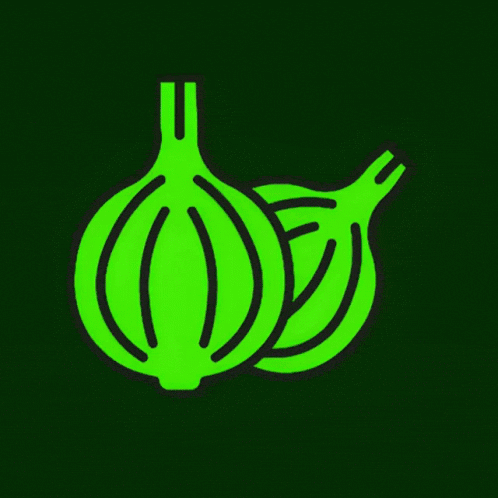
Fennel or onion: Fennel gives the dish a bit more body and a nice hint of anise, but onion is good, too, if you don't have a fennel bulb.
Mushrooms: Both white button mushrooms and cremini taste marvelous with the spinach. The cremini are meatier and earthier. In terms of nutrition, you can't go wrong with either!
Ginger root: Grate a fresh root or one that you've frozen. Powder is not as good as fresh in this curry.
Curry powder and assorted spices: If you want to double the curry powder instead of using the assortment of spices, go ahead. They are in the recipe to customize the flavor of the curry.
You may have a terrific DIY curry blend. If so, please use your homemade spice. I do recommend adding a generous pinch of cayenne pepper to help the enliven the dish.
Broth: Choose chicken or vegetable depending on dietary preferences.
Coconut milk: Full-fat has a glorious taste and thicken nicely. Low-fat is not as rich, but still good, and will save you a few grams of saturated fat. However, you may have to thicken the sauce with some cornstarch if you use low-fat.
Pasta: I developed the coconut curry sauce for chickpea pasta, but it will be fine with regular wheat pasta, or brown rice pasta. Choose a shape that will capture the sauce like rotini, penne, or rigatoni.
💚Spinach: Stir fresh, dark green leaves into the finished pasta dish at the end of cooking just until they are wilted. Kale, chard, or arugula are worthy substitutes.
How to Make It 🧑🏼🍳
As always, wash hands thoroughly before starting food prep.
Fill a medium pot halfway with water and bring to a boil. Cook the pasta while you are preparing the sauce.
Heat olive oil in a large skillet with high sides or a wok. Cook fennel or onion for 3 to 5 minutes, until slightly tender.
If using chicken breasts, cut them into cubes while the onion/fennel is cooking and add cubes once the vegetables are soft. As the chicken starts to brown, add the mushrooms.
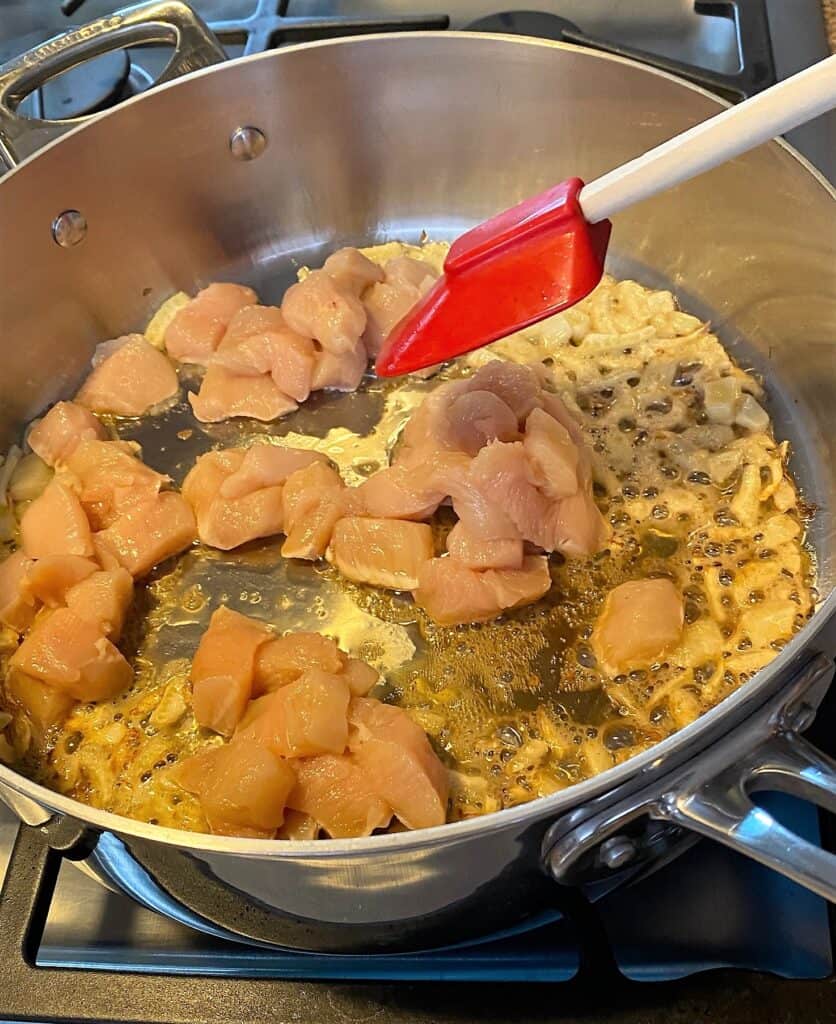
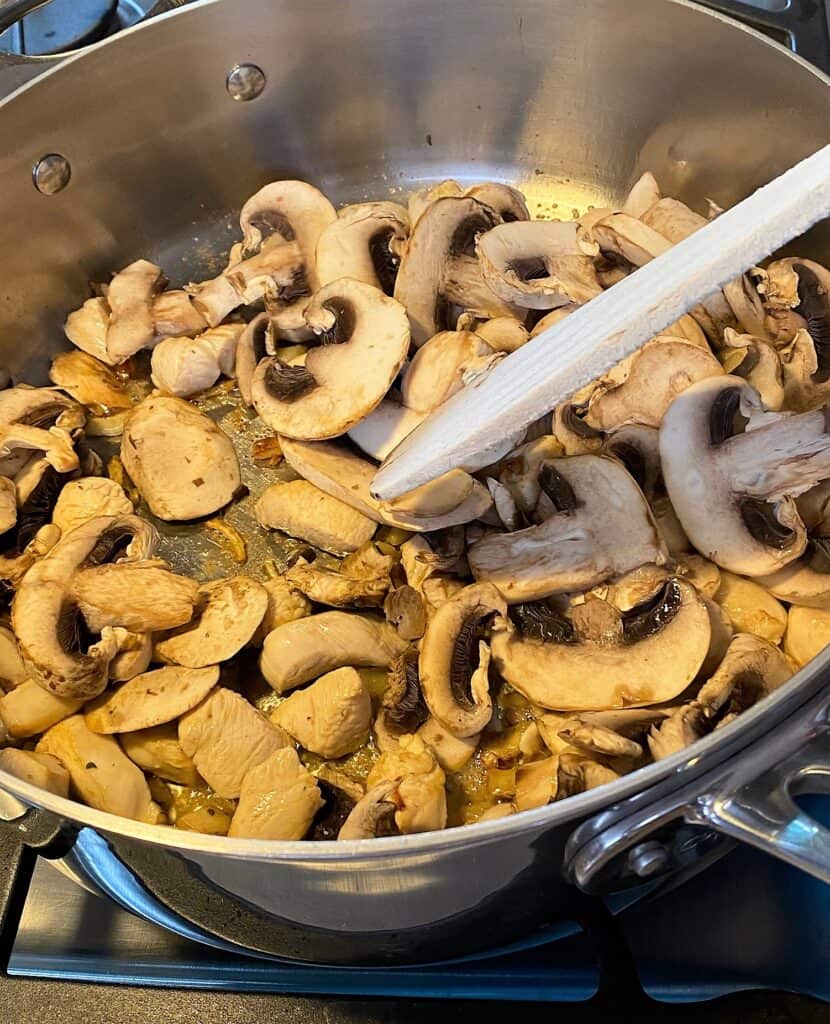
Cook until the mushrooms are soft and the chicken is cooked through.
Lower the heat and add the fresh ginger and dry spices including salt and pepper. Cook for a minute or two to warm the spices. The kitchen should be fragrant!
If using tofu cubes or shrimp rather than chicken, add it after you have warmed the spices. Cook, gently tossing the tofu pieces or shrimp to coat with the spice mixture. If using shrimp, turn the heat up a little and cook until they are translucent.
Deglaze the pan with broth and scrape up any bits stuck to the bottom. Turn the heat to medium high and bring to a boil. Boil for about three minutes until there is a sheen of liquid left in the pan.
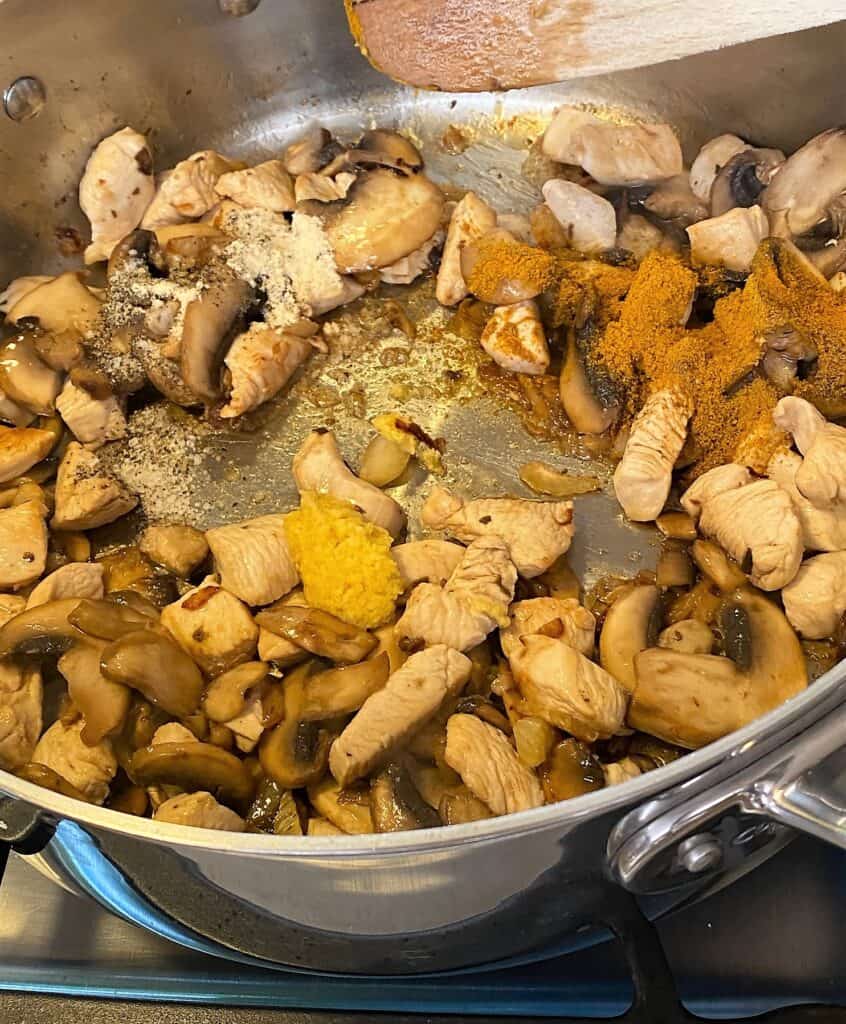
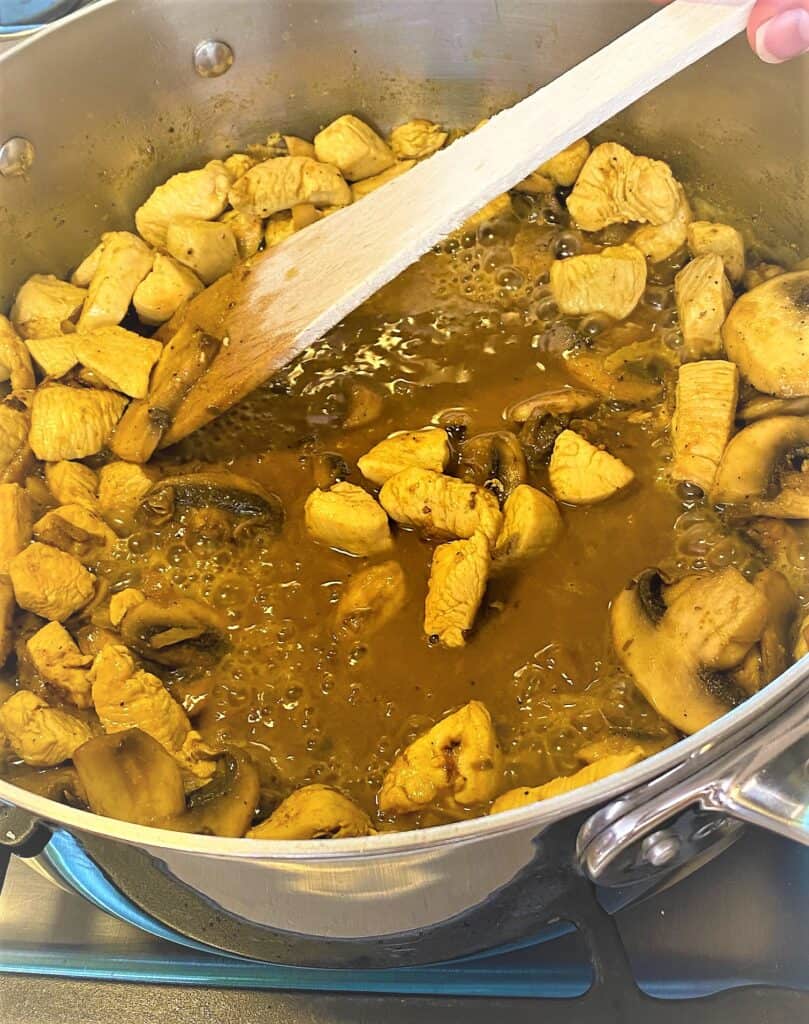
Lower the heat to medium and pour in the coconut milk. Bring to a gentle simmer and stir. Let it simmer and thicken for a few minutes.
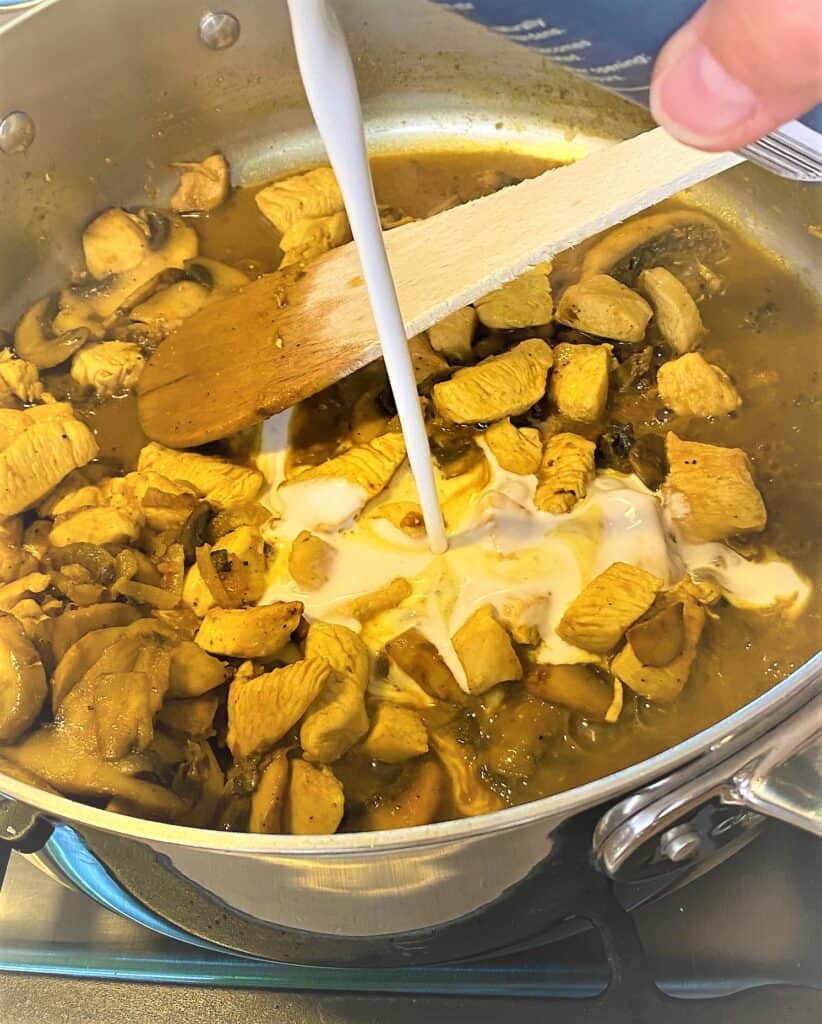
Note: If using "light" coconut milk, you can add some cornstarch dissolved in water at this point to make it thicken.
Once the sauce has thickened slightly, stir in the pasta, coating it with sauce.
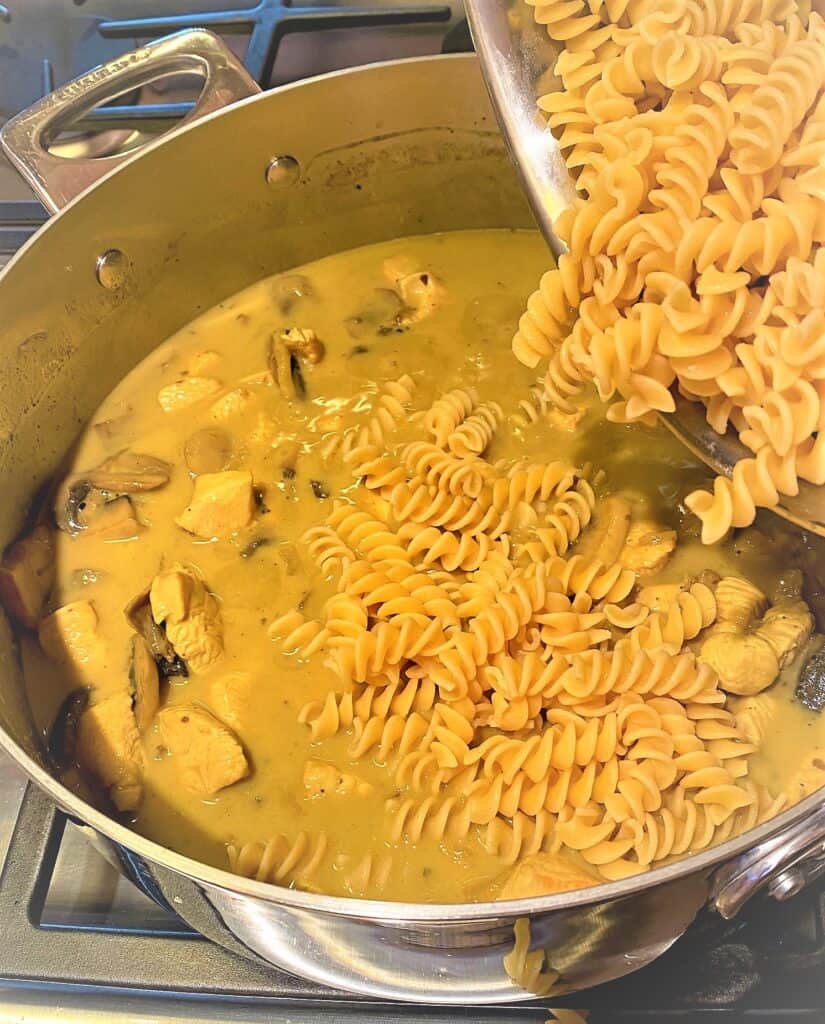
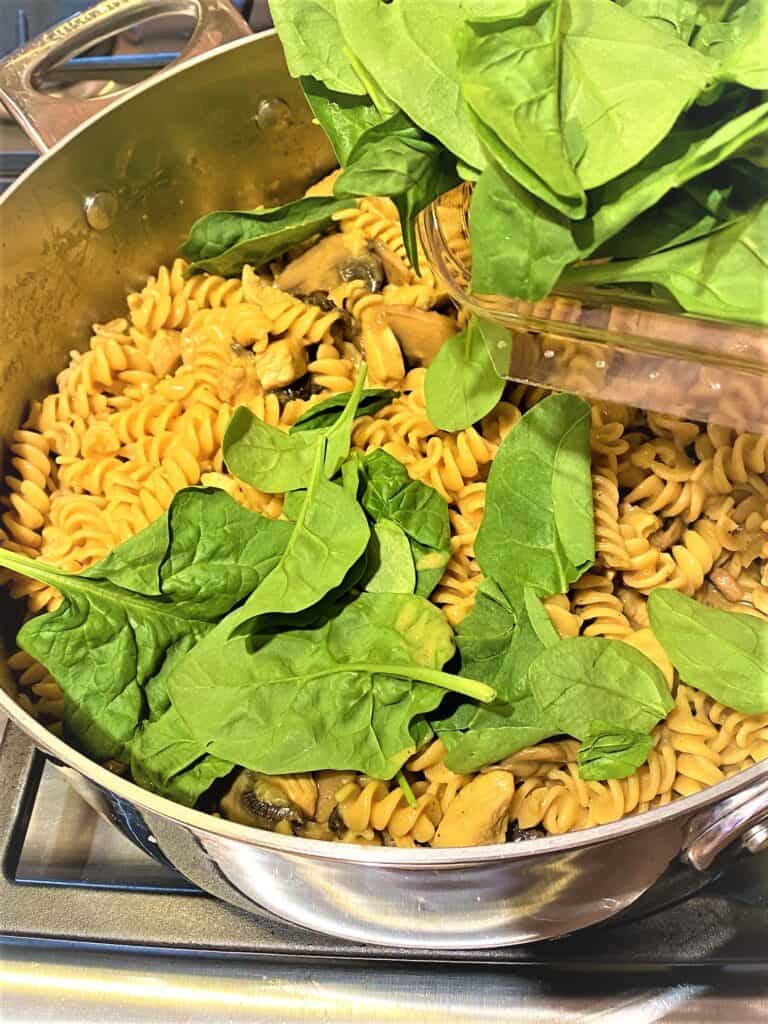
Turn the heat to low and toss handfuls of the spinach over the top. Stir in gently to wilt and serve.
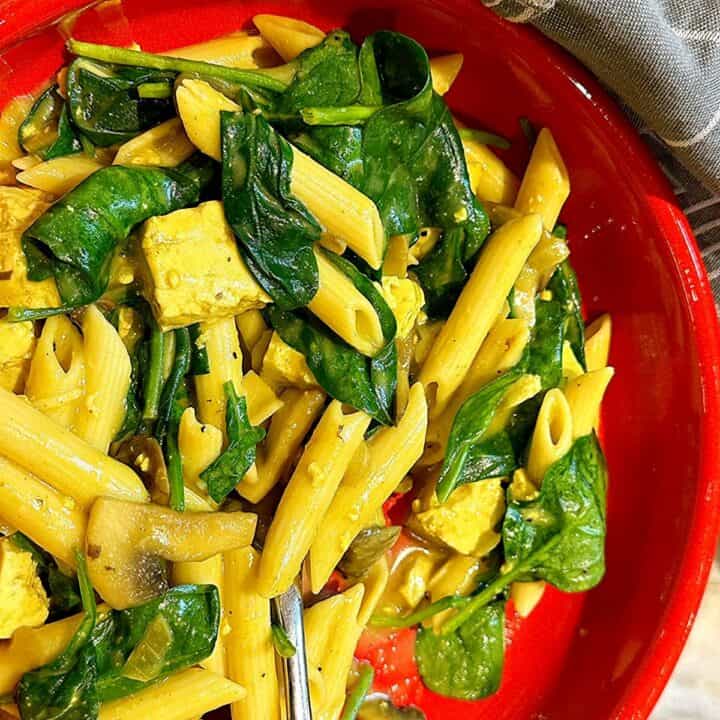
💟Why you'll love this recipe
The silky and delectably-spiced coconut sauce that coats the pasta and vegetables is irresistible!
It's very easy to customize for most dietary plans other than paleo or keto (since it contains pasta).
➡️It's perfect for allergies and sensitivities
This curried pasta is quick to prepare and an excellent dinner for families dealing with food allergies. My daughter, who loves pasta, has Eosinophilic Esophagitis (EoE).

Wheat and dairy can be some of the drivers of EoE, which is characterized by swallowing difficulties. In severe cases, food gets stuck or impacted in the esophagus.
The release of histamines, a reaction to the offending foods, causes a buildup of eosinophils in the esophagus.
This yummy curry is gluten- and dairy-free: perfect if you or those you know can't tolerate wheat or milk.
It's also free of tree nuts and eggs.
➡️High in protein
Although this creamy, vegetable-rich is not for paleo-diet followers since it contains pasta, it does boast a generous amount of protein.
Combining the chickpea pasta with lean chicken breast, tofu, or shrimp supplies more than 40 grams of protein in a serving. If you're on the small side, that's almost a day's worth of protein.
The Daily Recommended Intake (DRI) is a mere 0.8 g/kg/day or 0.36 g/lb/day of body weight.
If you weigh 150 pounds, that's about 54-55 grams of protein per day. If your weight is only 120 pounds, your requirement would be closer to 44 grams (just a gram more than a serving of this curry).
Many experts, however, agree that older adults and highly active individuals need more protein, roughly between 1.2 and 2 g/kg/day. (Note: A kilogram = 2.2 pounds.) This supports building and maintaining lean muscle tissue.
Aging slows the muscle-building process. You require more protein for muscle synthesis in old age. Preserving your muscle mass maintains mobility and function and has other health-enhancing benefits.
Those who exercise frequently or have a job or hobby that demands a high level of activity need to feed their muscle tissue with extra protein.
Credit: Olenka Kotyk on Unsplash
Protein is also your friend if you're trying to lose weight. Eating higher-protein meals and snacks helps to keep you from feeling hungry.
This curry is diabetic-friendly because it is well-balanced. It serves up carbohydrates and fats to go with the protein, as well as fiber and an array of micronutrients.
The Creamy Spinach and Mushroom Curry recipe makes a great meal for:
- those with allergies and sensitivities
- bodybuilders
- endurance and other athletes
- older adults
- active lifestyles
- overweight and obese people
- people with diabetes
Who shouldn't eat Coconut Chicken Curry (with mushrooms and spinach)
If you are allergic or sensitive to legumes, don't mess around with chickpea pasta. Chickpeas are a legume and even though they are further processed and made into flour for the pasta, the flour will trigger a response if you are sensitive to legumes.
This is not a good dish for people with poor kidney function who have lower protein requirements unless they undergo regular dialysis.

Young children may turn their noses up at this curry recipe. Although a few kids under the age of 8 may be adventurous, most prefer their pasta plainer.
Limiting carbs? Although chickpea pasta doesn't contain as many grams of carbs as wheat pasta, it is still carb-rich. If you are a keto devotee, this is not the meal for you.
If your gut is sensitive to FODMAP (Fermentable Oligosaccharides Disaccharides Monosaccharides And Polyols) foods, this dish could make you uncomfortable. Chickpea pasta contains fiber/oligosaccharides that feed the microbiome, which may bother sensitive guts.
To help your belly digest chickpea pasta, try drinking extra water with your meal. To read more about FODMAPS, peruse my sugar alcohol post, Erythritol et al. What the Heck is a Polyol?
The other thing to consider is the cost. Chickpea pasta is more expensive than regular pasta, and, it is often sold in smaller boxes. (For a small household, a trimmer box can be a plus.)
To summarize concerns with eating chickpea pasta and Creamy Coconut Chicken Curry:
- allergies to legumes
- can worsen poor kidney function (especially the complete recipe below)
- challenging flavors for young palates
- high in carbohydrates
- not for FODMOP/digestive sensitivities
- more expensive than wheat pasta
Chickpea pasta nutrition
Some manufacturers, such as Barilla, make the pasta from a single ingredient, chickpea flour. Others, like Banzaa, add tapioca, pea protein, and xanthan gum.
Protein: A 2-ounce serving of chickpea pasta offers 11 and 13 grams. This is about 40% more protein than the same-size serving of wheat pasta, which has 7 grams.
Minerals: This is where chickpea pasta really shines. It offers 3 to 4 mg of iron, 510 to 622 mg of potassium, at least 60 mg of magnesium and about 2 mg of zinc. It also has some calcium and phosphorous.
💪🏽Chickpea pasta is an excellent source of iron, supplying almost half of an adult man's daily needs (DRI). Regular durum semolina wheat pasta is fortified so it has nearly 2 mg per serving, but it still cannot match the amount in chickpea pasta.
Chickpea pasta is also a good to excellent source of zinc, potassium, and magnesium, a mineral that many people do not get enough of on a daily basis.
Regular wheat pasta contains about 30 mg of magnesium, half the amount in chickpea pasta.
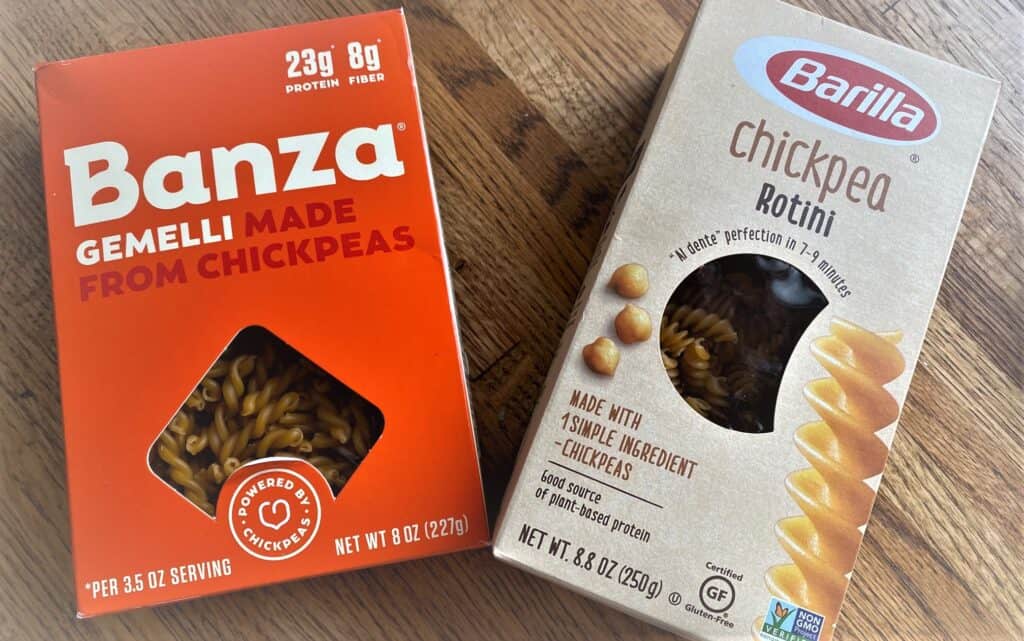
Fiber: There are 5 to 8 grams in a 2-ounce serving, which makes chickpea pasta a good to an excellent source of this gut health nutrient. It contains nearly equal amounts of soluble and insoluble fiber (roughage).
Soluble fiber is a prebiotic fiber that forms gels with water and is particularly helpful with gut health and blood sugar management. Insoluble fiber can't be broken down by gut microbes. It attracts water to the colon and speeds the transit of foods.
Vitamins: Chickpea pasta has a bevy of B vitamins, in particular thiamin (B1), folate (B9), and B6. It's especially rich in folate, which is important for a healthy pregnancy and a healthy heart.
Regular wheat pasta is fortified with B vitamins and contains plenty of folate, too. In chickpeas, these vitamins come from the legume and don't need to be added.
Fats: Chickpea pasta contains more fat than wheat pasta. It has 3.5 grams per 2-ounce serving so it is still a low-fat food.
Carbohydrates: With 32-34 grams per 2 ounces, it has fewer carbs than wheat pasta which weighs in at 42 grams for the same size serving. That said, chickpea pasta is not a low-carb food. If you have diabetes and count carbohydrates, a serving will count as 2 carbs.
Prep and Storage
You can prepare the cubes of chicken or tofu in advance and hold them for up to a day.
You could also wash and slice the mushroom and store those for a couple of days ahead of time.
The finished pasta curry will keep in the refrigerator for two to three days. If you are holding it to serve later, wait until you reheat it to wilt the spinach into the dish.
Why is this curry healthy?
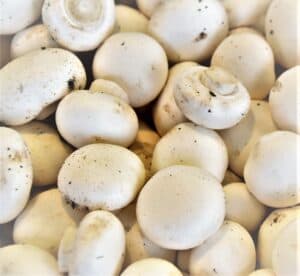
Mushrooms: They impart an umami flavor and supply beta-glucans, a soluble fiber with multiple health perks that include boosting immunity. They also have a bit of vitamin D, which can be hard to find in foods.
Spinach: This mild-tasting green is especially rich in vitamin K, which can help with calcium absorption. It also has iron. Even more important, spinach has some vitamin C to facilitate the uptake of iron.
Discover why Practical Dietitians rate this recipe as Best for Bones!

Spinach also adds texture and gorgeous color.
Spice blend: It has a good amount of ginger for digestion and curry spices for deliciousness and immunity. It does not contain hot red pepper since I created the recipe to ease any esophageal problems, including reflux (GERD). If you can tolerate it, feel free to add cayenne or red pepper flake!
🥥Coconut milk: For best taste, use full-fat coconut milk, which does contain a lot of saturated fat. But, plant-based saturated fat, may not drive heart disease in the same way as saturated fats from meat, according to the European Society of Cardiology (ESC). An ESC press release referred to study findings from more than 100,000 people in the UK Biobank, a large-scale database for biomedical research.
Other recipes you might like...
If you're looking for fast weeknight dinners, try my recipe for Smoked Sausages with Peppers and Onions. This sheet-pan meal is in and out of the oven in 30 minutes and uses healthy chicken sausages plus sweet red peppers and sliced onions.
If you're vegetarian and love pasta, this Spaghetti Napoli, is a fast fix. Make it with or without meat; you'll enjoy it either way!
Grilled Tofu Steaks are a meatless, hearty vegan meal of tofu slabs with an umami-rich Asian sauce.
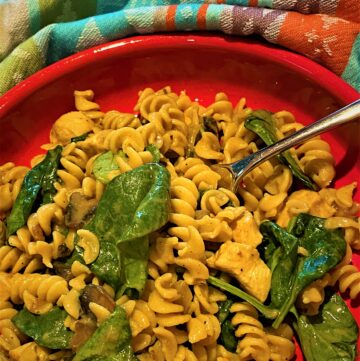
Spinach and Mushroom Curry with Creamy Coconut Sauce
Equipment
- Spatulas
Ingredients
- 2 Tablespoons olive oil
- 1 pound chicken breast, diced. Can use cubed tofu, or peeled, deviened shrimp in place of chicken.
- ½ cup fennel, finely chopped, or onion, diced
- 8 ounces mushrooms, sliced
- 1 Tablespoon fresh ginger root, grated
- 1 teaspoon curry powder
- ½ teaspoon garlic powder
- ½ teaspoon turmeric
- ½ teaspoon cumin
- ¼ teaspoon coriander
- ¼ teaspoon garam masala
- ½ cup chicken broth, or vegetable broth
- 8 ounces chickpea rotini pasta, or regular pasta
- 1 14-ounce can coconut milk. Use full-fat for best taste
- 3 ounces fresh spinach, about ⅔ of a 5-ounce carton
- Kosher salt, as desired (I use about ½ teaspoon)
- black pepper, as desired (I like ½ teaspoon freshly ground)
Instructions
- Gather ingredients, and wash hands according to CDC guidelines before starting to prep and cook.
- Bring a pot of water to boil to cook the pasta according to package directions while you're making the sauce.
- Heat olive oil in large skillet. Over medium-high heat, saute the chopped fennel or onion for 3 minutes. Add raw chicken cubes and cook until no longer pink.Wipe down any surfaces touched by the raw chicken with disinfectant spray, wipes, or hot, soapy water. Wash hands if they came in contact with the raw poultry. Reach for a clean spatula before preparing the rest of the recipe.
- Add mushrooms to the chicken-fennel mixture. Saute until the mushrooms begin to look slightly moist and soft.
- Add grated ginger and all spices including salt and pepper to the pan. Stir to coat the contents of the skillet and let spices bloom in the heat of the pan.
- If using tofu cubes or shrimp, add them at this point and push them around in the spices so they are coated.
- Pour in the broth and deglaze the pan, scraping up any brown bits. Cook for about 3 minutes, evaporating some of the liquid so that just a few centimeters of liquid are left in the pan.
- Turn the heat to low and stir in the coconut milk. Simmer for about 10 minutes. *Note: If the sauce seems too thin after simmering, you can thicken it with some cornstarch. Dissolve 1½ Tablespoons of cornstarch into 2 Tablespoons of water and stir into the coconut sauce.
- Pour the drained pasta into the sauce and stir to coat with the sauce.
- Turn the heat off and toss the spinach into the skillet. Stir to wilt. Serve immediately.
Video
Notes
Nutrition
COPYRIGHT © 2023 FOOD HALL BY JANI


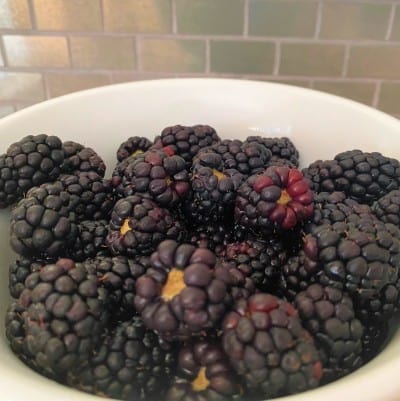

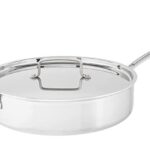
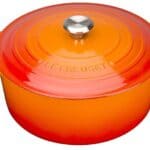
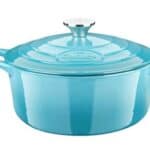


Jani H. Leuschel
Thank you! Hope you enjoy it! 😊
Mary Sallman
Great blog! Looking forward to trying it